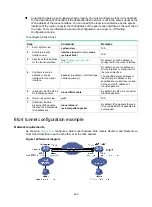
308
<RouterB> system-view
[RouterB] interface gigabitethernet 2/0/1
[RouterB-GigabitEthernet2/0/1] ip address 10.1.3.1 255.255.255.0
[RouterB-GigabitEthernet2/0/1] quit
# Specify an IPv4 address for Serial 2/1/1, which is the physical interface of the tunnel.
[RouterB] interface serial 2/1/1
[RouterB-Serial2/1/1] ip address 3.1.1.1 255.255.255.0
[RouterB-Serial2/1/1] quit
# Create the IPv4 over IPv4 tunnel interface Tunnel 2.
[RouterB] interface tunnel 2 mode ipv4-ipv4
# Specify an IPv4 address for the tunnel interface.
[RouterB-Tunnel2] ip address 10.1.2.2 255.255.255.0
# Specify the IP address of Serial 2/1/1 as the source address for the tunnel interface.
[RouterB-Tunnel2] source 3.1.1.1
# Specify the IP address of Serial 2/1/0 on Router A as a destination address for the tunnel
interface.
[RouterB-Tunnel2] destination 2.1.1.1
[RouterB-Tunnel2] quit
# Configure a static route destined for IPv4 group 1 through the tunnel interface.
[RouterB] ip route-static 10.1.1.0 255.255.255.0 tunnel 2
Verifying the configuration
# Use the
display interface tunnel
command to display the status of the tunnel interfaces on Router
A and Router B. Verify that the tunnel interfaces are up. (Details not shown.)
# Verify that Router A and Router B can ping the IPv4 address of the peer interface GigabitEthernet
2/0/1. The following shows the output on Router A.
[RouterA] ping -a 10.1.1.1 10.1.3.1
Ping 10.1.3.1 (10.1.3.1) from 10.1.1.1: 56 data bytes, press CTRL_C to break
56 bytes from 10.1.3.1: icmp_seq=0 ttl=255 time=2.000 ms
56 bytes from 10.1.3.1: icmp_seq=1 ttl=255 time=1.000 ms
56 bytes from 10.1.3.1: icmp_seq=2 ttl=255 time=0.000 ms
56 bytes from 10.1.3.1: icmp_seq=3 ttl=255 time=1.000 ms
56 bytes from 10.1.3.1: icmp_seq=4 ttl=255 time=1.000 ms
--- Ping statistics for 10.1.3.1 ---
5 packet(s) transmitted, 5 packet(s) received, 0.0% packet loss
round-trip min/avg/max/std-dev = 0.000/1.000/2.000/0.632 ms
Configuring an IPv4 over IPv6 manual tunnel
Follow these guidelines when you configure an IPv4 over IPv6 manual tunnel:
•
The tunnel destination address specified on the local device must be identical with the tunnel
source address specified on the tunnel peer device.
•
Do not specify the same source and destination addresses for local tunnel interfaces in the
same tunnel mode.
•
To ensure correct packet forwarding, identify whether the destination IPv4 network and the IPv4
address of the local tunnel interface are on the same subnet. If they are not, configure a route
reaching the destination IPv4 network through the tunnel interface. You can configure the route
by using one of the following methods:
















































